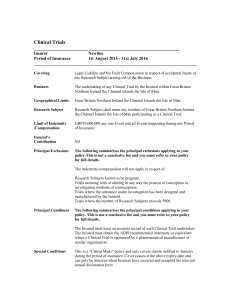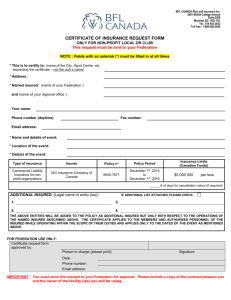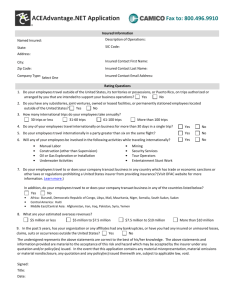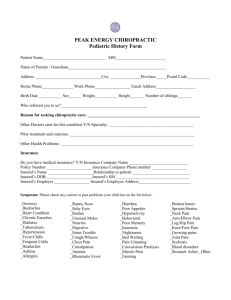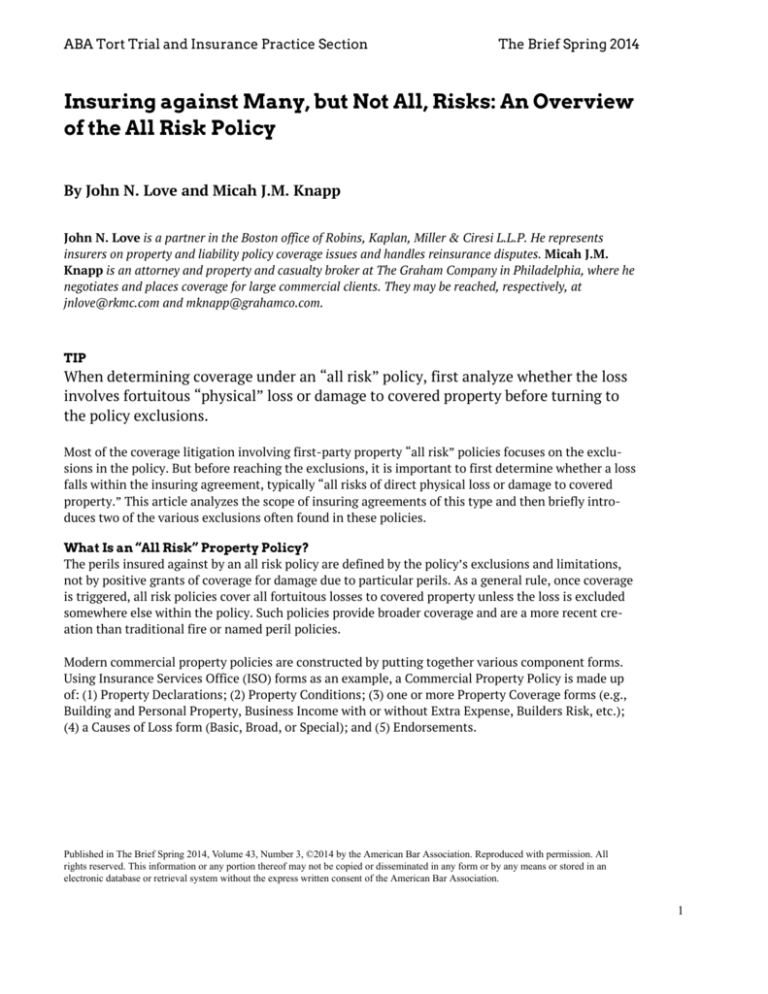
ABA Tort Trial and Insurance Practice Section
The Brief Spring 2014
Insuring against Many, but Not All, Risks: An Overview
of the All Risk Policy
By John N. Love and Micah J.M. Knapp
John N. Love is a partner in the Boston office of Robins, Kaplan, Miller & Ciresi L.L.P. He represents
insurers on property and liability policy coverage issues and handles reinsurance disputes. Micah J.M.
Knapp is an attorney and property and casualty broker at The Graham Company in Philadelphia, where he
negotiates and places coverage for large commercial clients. They may be reached, respectively, at
jnlove@rkmc.com and mknapp@grahamco.com.
TIP
When determining coverage under an “all risk” policy, first analyze whether the loss
involves fortuitous “physical” loss or damage to covered property before turning to
the policy exclusions.
Most of the coverage litigation involving first-party property “all risk” policies focuses on the exclusions in the policy. But before reaching the exclusions, it is important to first determine whether a loss
falls within the insuring agreement, typically “all risks of direct physical loss or damage to covered
property.” This article analyzes the scope of insuring agreements of this type and then briefly introduces two of the various exclusions often found in these policies.
What Is an “All Risk” Property Policy?
The perils insured against by an all risk policy are defined by the policy’s exclusions and limitations,
not by positive grants of coverage for damage due to particular perils. As a general rule, once coverage
is triggered, all risk policies cover all fortuitous losses to covered property unless the loss is excluded
somewhere else within the policy. Such policies provide broader coverage and are a more recent creation than traditional fire or named peril policies.
Modern commercial property policies are constructed by putting together various component forms.
Using Insurance Services Office (ISO) forms as an example, a Commercial Property Policy is made up
of: (1) Property Declarations; (2) Property Conditions; (3) one or more Property Coverage forms (e.g.,
Building and Personal Property, Business Income with or without Extra Expense, Builders Risk, etc.);
(4) a Causes of Loss form (Basic, Broad, or Special); and (5) Endorsements.
Published in The Brief Spring 2014, Volume 43, Number 3, ©2014 by the American Bar Association. Reproduced with permission. All
rights reserved. This information or any portion thereof may not be copied or disseminated in any form or by any means or stored in an
electronic database or retrieval system without the express written consent of the American Bar Association.
1
ABA Tort Trial and Insurance Practice Section
The Brief Spring 2014
The Causes of Loss—Special Form is what we refer to as the “all risk” form. The Causes of Loss—Basic
Form and Causes of Loss—Broad Form, on the other hand, afford varying degrees of named peril coverage. Read together, the insuring agreement within the Building and Personal Property Coverage Form
and Causes of Loss—Special (“All Risk”) Form define the essential grant of coverage afforded by the socalled all risk policy.
The ISO Building and Personal Property Coverage Form states that the insurer “will pay for direct
physical loss of or damage to Covered Property at the premises described in the Declarations caused by
1
or resulting from any Covered Cause of Loss.”
The Causes of Loss—Special (“All Risk”) Form, in turn, identifies covered causes of loss as “Risks of
Direct Physical Loss unless the loss is . . . [e]xcluded in Section B., Exclusions; or . . . [l]imited in Sec2
tion C., Limitations.”
“All Risk” Is Not “All Loss”
Before embarking on a discussion of physical damage, it is useful to relate that requirement to the fortuity requirement. The insured must prove that the physical damage is fortuitous. That is what is
3
meant by the term “risk.”
For example, an insured could not recover for the cost of asbestos removal necessitated by a decision
to demolish a building, even though the decision was made after the issuance of a property insurance
policy. The Sixth Circuit Court of Appeals explained this fortuity requirement in detail, stating: “Were
we to ignore plaintiff’s control over its loss in deciding the fortuitousness of plaintiff’s claim, we would
4
convert plaintiff’s all-risk insurance policy into a cash fund for plaintiff’s business plans.” The court
stated that under the modern rule, fortuity is a “subjective inquiry, based on what the parties knew or
reasonably should have known at the time the policy was entered, rather than as an objective determi5
nation based on hindsight.” But the damage must also be “unexpected damage, the occurrence of
6
which is outside the control of the parties.”
Another court held that enforcement of a court order for possession of property does not constitute a
7
fortuitous event. While arguably the court order was not within the “control” of the insured that was
ordered to relinquish the property, it is clear that the court was not going to equate a fortuitous event
under a property insurance policy with a facially valid (though later vacated) court order.
Loose language in some cases has spawned arguments that any fortuitous change in the state of property constitutes physical loss or damage. The Second Circuit quoted with approval the statement that
“‘physical loss or damage’ strongly implies that there was an initial satisfactory state that was changed
8
. . . into an unsatisfactory state.” Some insureds have argued that this allows them to obtain coverage
simply by proving that their property was working well at one point in time and now does not work
well. But this ignores the actual language of the insurance policy that requires physical loss or damage.
9
This type of argument was made and adopted by a New York appellate court. The claim involved “offtasting” of soft drink products resulting from faulty raw ingredients supplied to the insured by a third
party. The insurer, Winterthur, argued that the products were not physically damaged. The court ruled
in favor of the insured, stating:
Published in The Brief Spring 2014, Volume 43, Number 3, ©2014 by the American Bar Association. Reproduced with permission. All
rights reserved. This information or any portion thereof may not be copied or disseminated in any form or by any means or stored in an
electronic database or retrieval system without the express written consent of the American Bar Association.
2
ABA Tort Trial and Insurance Practice Section
The Brief Spring 2014
[W]e disagree with Winterthur that to prove “physical damages” the plaintiffs must prove that
“there has been a distinct demonstrable alteration of [the] physical structure [of the plaintiffs’
products] by an external force,” in other words, that the product has gone from good to bad. It
is sufficient under the circumstances of this case involving the unmerchantability of beverage
products that the product’s function and value have been seriously impaired, such that the
10
product cannot be sold.
We will return to this concept of whether the loss of function and value constitutes physical loss or
damage to property in the next section of this article.
“Physical Loss or Damage” to Covered Property
The trigger for coverage under an all risk policy (or named peril policy for that matter) is “physical loss
or damage” to covered property. As noted above, that trigger is found in the insuring agreement of the
Building and Personal Property Coverage Form. And it is the insured’s burden to establish the trigger
by proving physical loss or damage to covered property. Only after doing so does the burden shift to
the insurer to prove that an exclusion or limitation within the Causes of Loss—Special (“All Risk”)
Form or an Endorsement applies to bar coverage.
“Physical loss” to covered pro- perty. Theft is the main type of physical loss covered by the all risk
policy. When a thief steals covered real or business personal property, the insured company has suffered a physical loss. Similarly, covered real or business personal property that disappears in a tornado
or storm could also be a covered physical loss.
Of course, not all theft of personal property is covered under the all risk policy. The theft must be of
covered property, a category that is circumscribed by the terms of the Building and Personal Property
Coverage Form. The ISO form and most carriers’ forms specifically identify early in the policy form
“Property Not Covered,” which includes commonly stolen items such as money, securities, and
11
accounts, among other tangible property.
Moreover, what would otherwise appear to be a physical loss may be subject to an exclusion within the
Causes of Loss—Special (“All Risk”) Form. Two significant exclusions impacting coverage for physical
losses are the dishonest or criminal acts of officers or employees and unexplained losses where there is
12
no evidence of theft other than records of inventory.
“Physical damage” to covered property. “Physical damage” is not defined in most property policies.
Case law, however, generally defines physical damage as some sort of physical injury or alteration to
tangible property. Obvious examples include a building burned in a fire or lightning strike, or windows
and exterior siding broken by vandals. Courts have generally held that intangible or purely economic
13
losses are not “physical” damage and, therefore, do not trigger coverage under the all risk policy.
Moreover, the property physically damaged must be covered property as identified in the Building and
Personal Property Coverage Form. Subject to coverage extensions and additional coverages afforded
later in the all risk policy, physical injury to paper money, land, crops, bridges, and other property
listed as property not covered in the Building and Personal Property Coverage Form is not contemplated within the all risk coverage.
Published in The Brief Spring 2014, Volume 43, Number 3, ©2014 by the American Bar Association. Reproduced with permission. All
rights reserved. This information or any portion thereof may not be copied or disseminated in any form or by any means or stored in an
electronic database or retrieval system without the express written consent of the American Bar Association.
3
ABA Tort Trial and Insurance Practice Section
The Brief Spring 2014
Stretching the limits of “physical damage.” The infiltration of an odor from a methamphetamine
14
lab was held to be insured physical damage by the Oregon Court of Appeals. The court accepted a
trial court finding that “a pervasive odor persists in the house” and concluded that this odor was
15
“physical” because it damaged the house.
Claims involving electronic data also push against the outer limits of physical loss or damage. Unlike
commercial general liability (CGL) policies, first-party property policies are not intended to cover mere
loss of use. CGL policies actually define the term “property damage” to include “[l]oss of use of tangi16
ble property that is not physically injured.” By contrast, property insurance policies require “physical
loss or damage.” The cases discussed below illustrate this distinction.
In NMS Services Inc. v. Hartford, NMS suffered a business interruption loss when a former employee
sabotaged its computer system, erasing vital computer files and databases necessary for business oper17
ations. NMS sought coverage under a business income additional coverage provision that applied
when a suspension of business is caused by direct physical loss of or damage to property. The court
found that there was “no question that NMS suffered damage to its property, specifically, damage to
18
the computers it owned.” It was Judge Widener’s concurring opinion, however, that further explained
why the erasure of the computer data itself constituted direct physical loss: “[T]his erasure was, in fact,
a ‘direct physical loss’ . . . . [A] computer stores information by the rearrangement of the atoms or molecules of a disc or tape to effect the formation of a particular order of magnetic impulses, and a mean19
ingful sequence of magnetic impulses cannot float in space.”
Not all courts, however, have found that damage to data constitutes direct physical loss of or damage
to property under property insurance policies. In Ward General Insurance Services, Inc. v. Employers Fire
Insurance Co., the court stated that “the loss of a database is the loss of organized information, in this
20
case, the loss of client names, addresses, policy renewals dates, etc.” As the court further explained:
Here, the loss suffered by plaintiff was a loss of information, i.e., the sequence of ones and
zeros stored by aligning small domains of magnetic material on the computer’s hard drive in a
machine readable manner. Plaintiff did not lose the tangible material of the storage medium.
Rather, plaintiff lost the stored information. The sequence of ones and zeros can be altered,
rearranged, or erased, without losing or damaging the tangible material of the storage
21
medium.
In an effort to avoid disputes on data losses, the ISO Building and Personal Property Coverage Form
22
lists “[e]lectronic data” as property not covered. The same form gives back some limited electronic
data coverage in the form of an additional coverage with a standard $2,500 sublimit for the cost to
23
restore electronic data.
Mere loss of use is not physical loss or damage. In Pentair, Inc.v. American Guarantee & Liability
Insurance Co., the insured argued that a power outage that shut down a factory constituted direct phys24
ical loss or damage. The Eighth Circuit found that the policy covering “all risk of direct physical loss
of or damage to property” did not cover the factory shutdown. The court pointed out that the insured’s
argument, if adopted, “would mean that direct physical loss or damage is established whenever prop-
Published in The Brief Spring 2014, Volume 43, Number 3, ©2014 by the American Bar Association. Reproduced with permission. All
rights reserved. This information or any portion thereof may not be copied or disseminated in any form or by any means or stored in an
electronic database or retrieval system without the express written consent of the American Bar Association.
4
ABA Tort Trial and Insurance Practice Section
The Brief Spring 2014
25
erty cannot be used for its intended purpose.” It ruled that although electric power has a physical element, the shutdown of this factory did not constitute the direct physical loss or damage under the
insurance policy required to trigger lost income coverage.
The Eighth Circuit rejected a similar argument in Source Food Technology, Inc. v. U.S. Fidelity & Guar26
anty Co. There, the insured was prevented from bringing its beef products from Canada into the
United States when the border was closed to the importation of beef during the mad cow scare. There
was nothing wrong with the insured’s beef, but it lost the use of that beef when it could not import it
for sale in the United States. Source Food argued that the “function and value” of its beef was impaired
27
by the border closing. The Eighth Circuit rejected this argument, stating: “To characterize Source
Food’s inability to transport its truckload of beef product across the border . . . as direct physical loss to
28
property would render the word ‘physical’ meaningless.”
The New York Appellate Division reached the same conclusion in Roundabout Theatre Co. v. Continental
29
Casualty Co. Damage to a building near the theater closed the roads and made the theater inaccessible. The court found no coverage for the theater’s lost income claim because the policy required that
30
there be “direct physical loss or damage to the property” described in the policy. The theater was not
closed because it was damaged, but rather because it was inaccessible. While the theater owners lost
the function and value of their theater during this time, the court held that this was not sufficient to
trigger coverage under the interruption, postponement, or cancellation section of the all risk policy.
But loss of use caused by physical change to the property may be covered. In General Mills, Inc. v.
Gold Medal Insurance Co., a contractor hired by the insured sprayed its grain with an unapproved pesti31
cide. Although it was nearly identical to approved pesticides and there was no evidence that it was
dangerous or not fit for human consumption, it still violated FDA regulations on adulteration of food
products. The insured voluntarily discarded the grain, believing that it could not obtain an FDA waiver
and not wanting to risk a public relations problem. The insurer argued that the grain had not been subject to physical damage. The Minnesota Supreme Court held that this loss was covered. It stated that
the trial court “did not err in finding this to be an impairment of function and value sufficient to sup32
port a finding of physical damage.” While this case is sometimes cited for the proposition that loss of
use can constitute physical loss or damage, there was, in fact, a physical change to the insured’s grain.
It was sprayed with the unapproved pesticide. This is an example where the loss of use was actually
caused by a physical change to the property.
Imminent Threat of Physical Loss or Damage May Trigger Coverage
The all risk policy affords some coverage for measures taken to prevent threatened damage to covered
property. Most Building and Personal Property Coverage forms, including the standard ISO form,
incorporate an additional coverage for the preservation of property. The provision extends coverage to
covered property moved away from the premises identified in the declarations for a period of up to 30
33
days as long as the move was necessary to protect the covered property from a covered cause of loss.
The Causes of Loss—Special (“All Risk”) Form also affords some coverage for property damaged intentionally in order to avoid a larger, imminent harm. The form includes an exception to the governmental action exclusion that grants coverage for “loss or damage caused by or resulting from acts of
34
destruction ordered by governmental authority and taken at the time of a fire to prevent its spread.”
Published in The Brief Spring 2014, Volume 43, Number 3, ©2014 by the American Bar Association. Reproduced with permission. All
rights reserved. This information or any portion thereof may not be copied or disseminated in any form or by any means or stored in an
electronic database or retrieval system without the express written consent of the American Bar Association.
5
ABA Tort Trial and Insurance Practice Section
The Brief Spring 2014
Some property policies also include sue and labor clauses that afford coverage for costs incurred by the
insured to protect covered property from a covered peril. Sue and labor clauses obligate the insured to
take steps to protect covered property from threatened losses and obligate the insurer to reimburse the
insured for those costs. Such provisions, however, do not provide an independent basis for recovery
and will only be triggered if the peril sought to be avoided is covered in and not excluded by the policy.
[T]he purpose of the sue and labor clause is to reimburse the insured for costs incurred to satisfy the insured’s duty to the insurer. If the insured acts to prevent a loss that is not covered
by the policy, there is no duty or benefit to insurer; “[t]he obligation only exists when the
35
action taken is to prevent a loss for which the underwriter would be liable.”
Introduction to Exclusions
Wear and tear—deterioration. The standard all risk policy language excludes damage due to “[w]ear
36
and tear.” Within the same paragraph, the policy excludes inherent vice/latent defects such as rust,
37
decay, rot, corrosion, smog, settling and cracking, and nesting or infestation of animals and insects.
The basis for the exclusion is that wear and tear is not a fortuitous event. Rather, wear and tear is
expected and ordinary, and may be remedied by proper maintenance.
Accordingly, a policyholder who fails to maintain its property cannot look to its property insurer to
repair damage due to ordinary wear. In Johnson Press of America, Inc. v. Northern Insurance Co. of New
38
York, the roof above the insured’s two adjacent buildings collapsed. But long before the collapse, the
insured saw that portions of the roof and floors were missing, a stairwell was partially collapsed, and
there was water damage and fungal growth throughout the building. The Appellate Court of Illinois
affirmed summary judgment in the insurer’s favor, holding that the collapse was not fortuitous, but
rather the result of several excluded causes, including wear and tear.
Faulty workmanship or design. The Causes of Loss—Special (“All Risk”) Form excludes loss or damage caused directly or indirectly by “[f]aulty, inadequate or defective . . . [d]esign, specifications, workmanship, repair, construction, renovation, remodeling, grading, [or] compaction . . . of part or all of
39
any property on or off the described premises.” The exclusion bars coverage for what would be fortuitous losses from the standpoint of the insured property owner, even if the damage was foreseeable to
the contractor who performed the work. Indeed, damage that results from faulty construction or design
performed years earlier is not necessarily something that a property owner could foresee. By inserting
the exclusion, however, insurers avoid being the guarantor of the work performed by an unknown contractor, repairman, or architect.
The all risk policy provides some coverage for faulty workmanship losses. Most notably, the additional
coverage for collapse covers abrupt collapse of a building caused by hidden insect or vermin damage,
hidden decay, use of defective material or methods in construction or repair if collapse occurs during
the work. The provision also covers collapse after the work is completed where the collapse is partially
due to the use of defective material or methods in construction or repair, as long as the loss was caused
in part by specifically identified perils, including hidden decay or insect damage, or the weight of peo40
ple or personal property.
Published in The Brief Spring 2014, Volume 43, Number 3, ©2014 by the American Bar Association. Reproduced with permission. All
rights reserved. This information or any portion thereof may not be copied or disseminated in any form or by any means or stored in an
electronic database or retrieval system without the express written consent of the American Bar Association.
6
ABA Tort Trial and Insurance Practice Section
The Brief Spring 2014
The givebacks found in the additional coverage for collapse afford businesses important protection
given recent case law excluding damage to a customer’s property from coverage in contractors CGL and
builders risk policies. Courts in several states, including Delaware, the District of Columbia, Montana,
Pennsylvania, and Wyoming, have held that construction defects are not “occurrences” and that
resulting damage to a client’s property from faulty workmanship is not covered by the builders CGL
41
policy.
Conclusion
All risk policies are much broader than named peril policies, but they are not “all loss” policies. The
first step in analyzing coverage for a particular loss should be determining whether that loss falls
within the insuring agreement of the policy. Was the loss fortuitous? Did it occur to covered property?
Was that property “physically” lost or damaged? Was there merely loss of use of the property, or was
the loss of use caused by a physical change to the property? Was the loss incurred to prevent physical
loss or damage to that property or other covered property? Only after answering these questions do the
policy exclusions become relevant.
Notes
1. Ins. Servs. Office, Inc. (ISO), Bldg. & Pers. Prop. Coverage Form CP 00 10 04 02, ¶ A.
2. Ins. Servs. Office, Inc. (ISO), Causes of Loss—Special Form CP 10 30 04 02, ¶ A.
3. Univ. of Cincinnati v. Arkwright Mut. Ins. Co., 51 F.3d 1277 (6th Cir. 1995); Harbor House Condo.
Ass’n v. Mass. Bay Ins. Co., 703 F. Supp. 1313 (N.D. Ill. 1988), aff’d, 915 F.2d 316 (7th Cir. 1990).
4. Univ. of Cincinnati, 51 F.3d at 1282.
5. Id. at 1283.
6. Id. at 1284.
7. Intermetal Mexicana, S.A. v. Ins. Co. of N. Am., 866 F.2d 71 (3d Cir. 1989).
8. City of Burlington v. Indem. Ins. Co., 332 F.3d 38, 48 (2d Cir. 2003) (quoting Trinity Indus., Inc. v.
Ins. Co. of N. Am., 916 F.2d 267, 270–71 (5th Cir. 1990)).
9. Pepsico, Inc. v. Winterthur Int’l Am. Ins. Co., 806 N.Y.S.2d 709 (App. Div. 2005).
10. Id. at 711 (alterations in original).
11. See, e.g., ISO Bldg. & Pers. Prop. Coverage Form CP 00 10 04 02, ¶ A.2.
12. See, e.g., ISO Causes of Loss—Special Form CP 10 30 04 02, ¶¶ B.2.h., C.1.e.
13. See10A STEVEN PLITT ET AL., COUCH ON INSURANCE § 148:46 (3d ed. 2010).
14. Farmers Ins. Co. of Or. v. Trutanich, 858 P.2d 1332 (Or. Ct. App. 1993).
15. Id. at 1335.
16. See, e.g., Ins. Servs. Office, Inc. (ISO), Commercial Gen. Liab. Coverage Form CG 00 01 12 07,
¶ V.17.b.
17. 62 F. App’x 511 (4th Cir. 2003).
18. Id. at 514.
19. Id. at 515 (Widener, J., concurring) (internal quotation marks omitted).
20. 7 Cal. Rptr. 3d 844, 850 (Ct. App. 2003).
21. Id. at 851 (footnote omitted).
22. ISO Bldg. & Pers. Prop. Coverage Form CP 00 10 04 02, ¶ A.2.n.
23. Id. ¶ A.4.f.
24. 400 F.3d 613 (8th Cir. 2005).
25. Id. at 616.
Published in The Brief Spring 2014, Volume 43, Number 3, ©2014 by the American Bar Association. Reproduced with permission. All
rights reserved. This information or any portion thereof may not be copied or disseminated in any form or by any means or stored in an
electronic database or retrieval system without the express written consent of the American Bar Association.
7
ABA Tort Trial and Insurance Practice Section
The Brief Spring 2014
26. 465 F.3d 834 (8th Cir. 2006).
27. Id. at 836.
28. Id. at 838.
29. 751 N.Y.S.2d 4 (App. Div. 2002).
30. Id. at 7–8.
31. 622 N.W.2d 147 (Minn. 2001).
32. Id. at 152.
33. See, e.g., ISO Bldg. & Pers. Prop. Coverage Form CP 00 10 04 02, ¶ A.4.b.
34. ISO Causes of Loss—Special Form CP 10 30 04 02, ¶ B.1.c.
35. GTE Corp. v. Allendale Mut. Ins. Co., 372 F.3d 598, 618 (3d Cir. 2004) (alterations in original)
(quoting GTE Corp. v. Allendale Mut. Ins. Co., 258 F. Supp. 2d 364, 373 (D.N.J. 2003)) (holding an
insured’s claim for reimbursement for costs incurred to avoid Y2K disruptions not covered by sue and
labor clause).
36. See, e.g., ISO Causes of Loss—Special Form CP 10 30 04 02, ¶ B.2.d.(1).
37. See, e.g., id. ¶ B.2.d.
38. 791 N.E.2d 1291 (Ill. App. Ct. 2003).
39. ISO Causes of Loss—Special Form CP 10 30 04 02, ¶ B.3.c.
40. Id. ¶ D.
41. See, e.g., Millers Capital Ins. Co. v. Gambone Bros. Dev. Co., 941 A.2d 706, 714 (Pa. Super. Ct.
2007) (holding “rainfall that seeps through faulty home exterior work to damage the interior of a home
is not a fortuitous event that would trigger coverage” under the contractors CGL policy).
Published in The Brief Spring 2014, Volume 43, Number 3, ©2014 by the American Bar Association. Reproduced with permission. All
rights reserved. This information or any portion thereof may not be copied or disseminated in any form or by any means or stored in an
electronic database or retrieval system without the express written consent of the American Bar Association.
8



